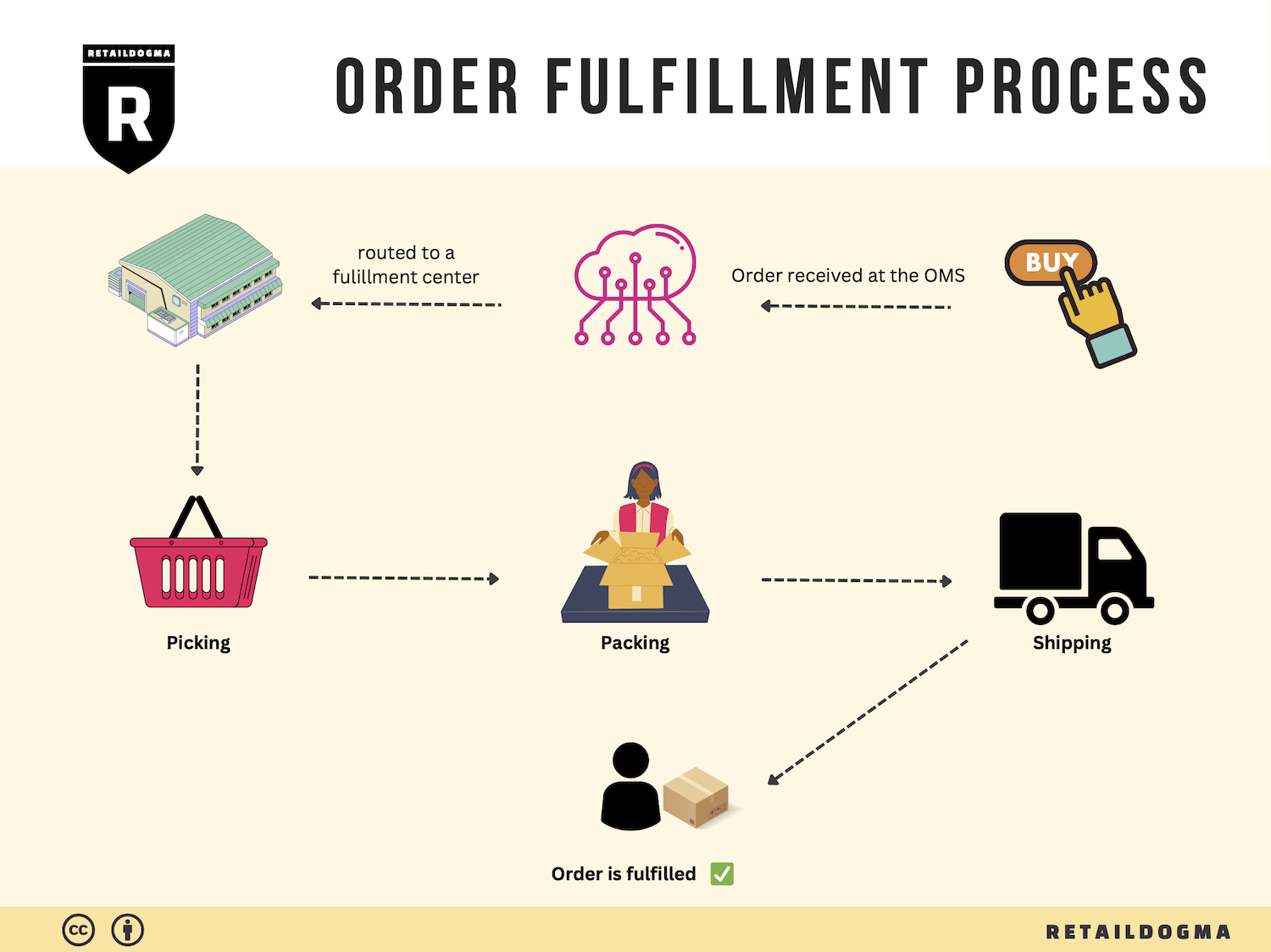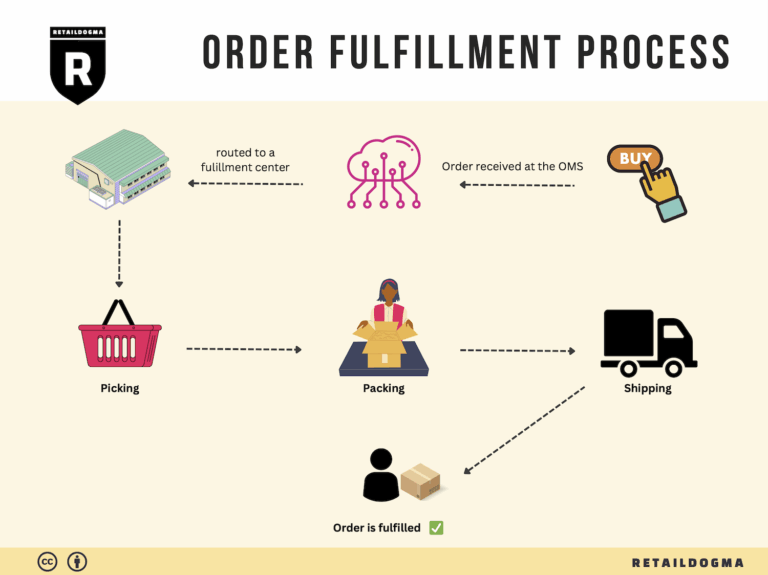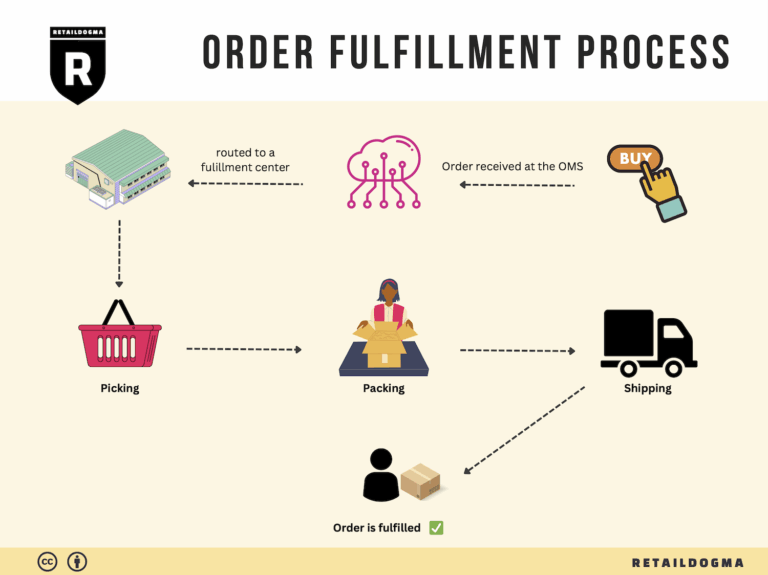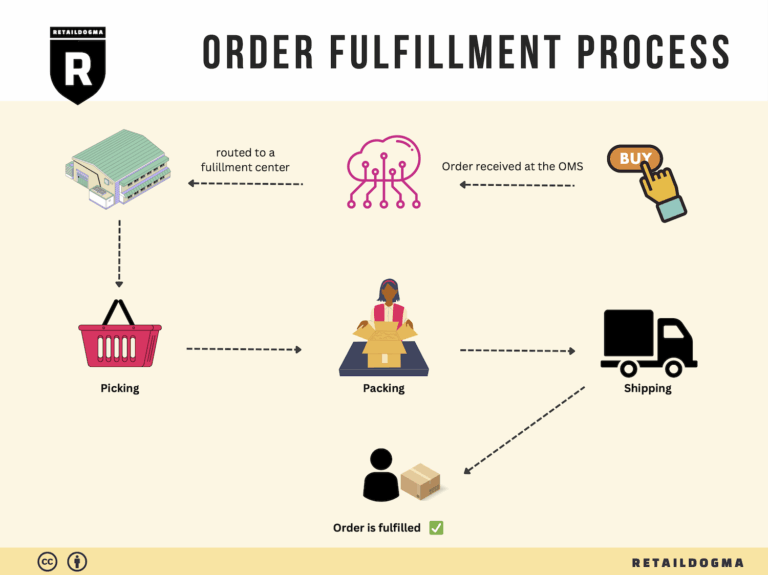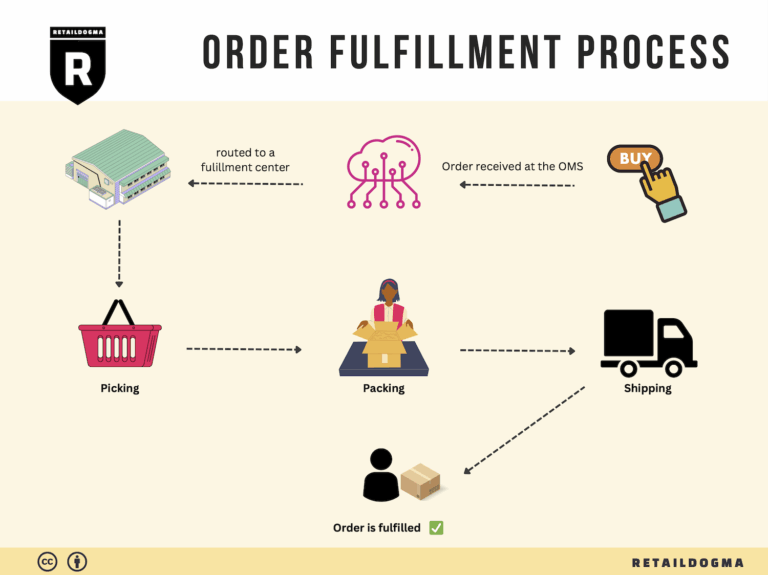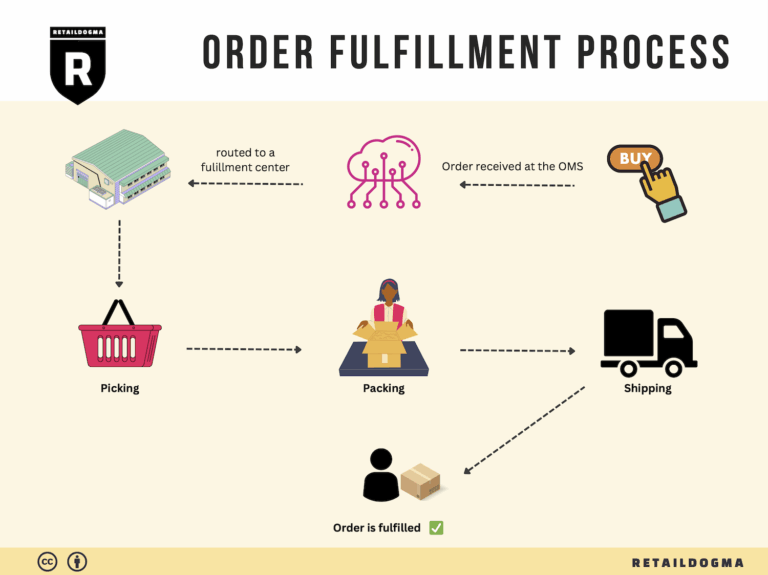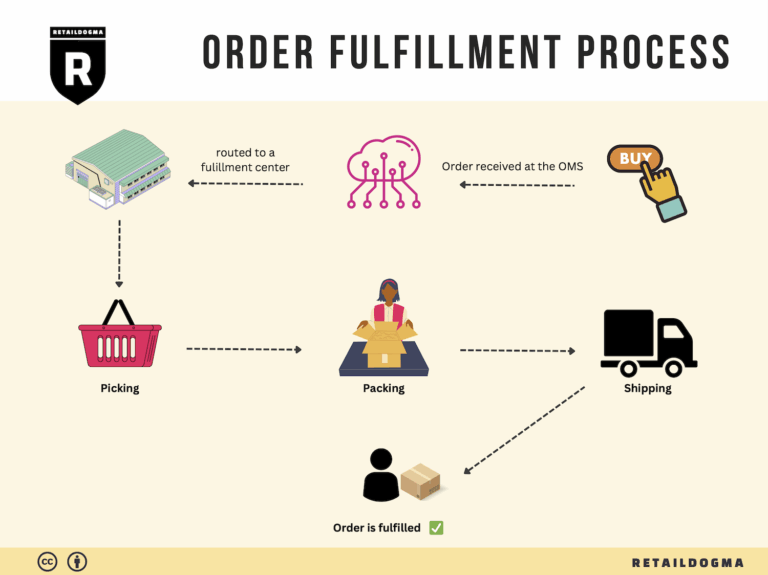How Order Fulfillment Works: A Step-by-Step Guide for Businesses
What is E-commerce Fulfillment? An Introduction for Growing Businesses
Understanding E-commerce Fulfillment: A Key to Scaling Your Business
As an e-commerce business owner, you may find yourself drowning in the overwhelming tasks of packing and shipping orders. Managing these logistics can quickly become a burden, diverting your attention from growth strategies and customer engagement. This is where e-commerce fulfillment comes into play. At its core, fulfillment is the process of getting a product from your inventory to your customer’s doorstep. It’s a vital component of your business that directly impacts customer satisfaction and your bottom line.
In this guide, we will explore the various models of e-commerce fulfillment, such as Third-Party Logistics (3PL) and Fulfillment by Amazon (FBA), helping you understand which might be the best fit for your business needs. Each model offers distinct advantages and challenges, and selecting the right one can be crucial as you scale.
We will delve into the core services involved in fulfillment, including inventory management, order processing, packing, shipping, and returns handling. Understanding these services will help you identify what you require from a fulfillment partner to ensure seamless operations and a positive customer experience.
Choosing the right fulfillment partner is another critical aspect we’ll cover. Factors such as location, technology integration, compliance with retailer requirements, and service level agreements (SLAs) should all influence your decision. A reliable partner can not only streamline your logistics but also provide you with valuable insights to enhance your operations.
Pricing is often a concern for growing businesses, and we’ll break down the costs associated with different fulfillment models. Understanding the pricing structures will enable you to make informed decisions that align with your budget and growth objectives.
The ultimate goal of this guide is to empower you, the business owner, to make smart decisions about your logistics. By providing clear insights into e-commerce fulfillment, we aim to help you navigate this complex landscape, enabling you to focus on what you do best: growing your brand and serving your customers. Whether you’re just starting or looking to optimize your existing fulfillment processes, the information contained in this guide will equip you with the knowledge to enhance your operations and drive success in the competitive e-commerce space.
What You’ll Learn In This Guide
- What is E-commerce Fulfillment? An Introduction for Growing Businesses
- The Order Fulfillment Process: From ‘Buy’ Button to Customer’s Door
- Comparing Fulfillment Models: In-House vs. 3PL vs. Dropshipping
- A Deep Dive into Amazon FBA: Pros, Cons, and Who It’s For
- Core Services Offered by Fulfillment Centers
- How to Choose a Fulfillment Partner: A 6-Point Checklist
- Understanding Fulfillment Pricing: A Breakdown of Common Fees
- Frequently Asked Questions (FAQs) about Fulfillment
- Conclusion: Is Outsourcing Fulfillment the Right Move for Your Business?
- Important Disclaimer
The Order Fulfillment Process: From ‘Buy’ Button to Customer’s Door
1. Receiving Inventory
The order fulfillment process begins with receiving inventory, a critical step that sets the foundation for efficient operations. During this phase, products are delivered from suppliers to the fulfillment center. This involves checking the incoming shipments against purchase orders to ensure accuracy and completeness. Key metrics at this stage include receiving accuracy, which ensures that the right quantities and items are accepted into the inventory.
Why It’s Important: Proper inventory receiving is essential to prevent stock discrepancies that can lead to out-of-stock situations or fulfillment errors later in the process. By implementing a robust receiving system, businesses can minimize errors and streamline their operations.
Key Term: SKU (Stock Keeping Unit) – A unique identifier for each product, which simplifies tracking and inventory management.
2. Warehouse Storage
Once the inventory is received and verified, the next step is warehouse storage. This involves organizing products in the fulfillment center in a way that maximizes space and facilitates easy access. Efficient storage systems, including shelving, pallet racks, and bins, are employed to categorize and store products logically.
Why It’s Important: Effective warehouse storage ensures that items are easily retrievable when orders are placed, reducing the time spent locating products. A well-organized warehouse can significantly improve the overall speed of the fulfillment process, ultimately leading to higher customer satisfaction.
Key Term: ABC Analysis – A method of categorizing inventory based on importance, where ‘A’ items are high-value and low-quantity, ‘B’ items are moderate in both value and quantity, and ‘C’ items are low-value but high-quantity. This helps prioritize storage and retrieval efforts.
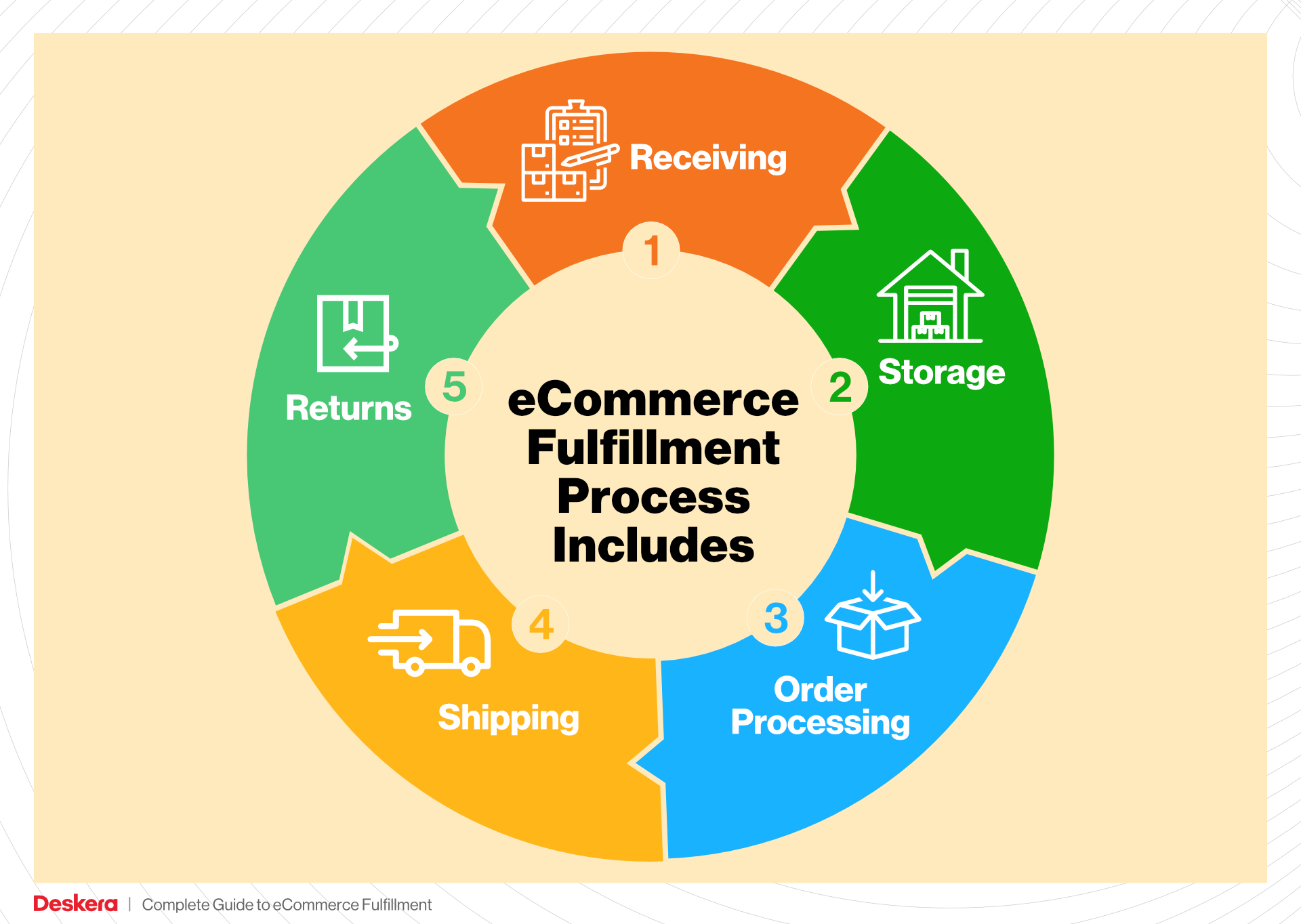
3. Order Picking
The order picking stage is where the actual fulfillment begins. When a customer places an order, a pick list is generated, detailing the items to be collected from the warehouse. Warehouse staff, often equipped with handheld devices or pick-to-light systems, locate and gather the items listed on the pick list.
Why It’s Important: Accurate order picking is crucial for maintaining customer satisfaction. Errors in this phase can lead to incorrect shipments, returns, and ultimately lost customers. Efficient picking processes can also reduce labor costs and improve overall productivity.
Key Term: Pick Lists – Documents or digital lists that guide warehouse staff on which items to retrieve for fulfilling customer orders. They are essential for maintaining order accuracy and speed.
4. Order Packing
After items are picked, they move to the packing station. Here, products are carefully packed into boxes or envelopes, ensuring they are secure for transit. This phase often includes quality checks to confirm that the correct items are being shipped. Packing materials such as bubble wrap, packing peanuts, or custom boxes may be used to protect items during shipping.
Why It’s Important: Proper packing is vital to prevent damage during transit, which can lead to returns and dissatisfaction. Effective packing also enhances the unboxing experience for customers, which is increasingly important in today’s e-commerce landscape.

Key Term: Packing Slip – A document included with the shipment that lists the items packed, serving as a receipt for the customer and a record for inventory management.
5. Shipping & Delivery
The final step in the order fulfillment process is shipping and delivery. Once orders are packed, they are labeled and handed over to shipping carriers for delivery to customers. This phase includes selecting the best shipping method based on factors such as cost, speed, and destination. Automation tools can assist in generating shipping labels and tracking numbers.
Why It’s Important: Timely shipping is crucial for meeting customer expectations. Delays in this phase can lead to negative reviews and reduced customer loyalty. Additionally, having a reliable shipping strategy can optimize costs and improve overall operational efficiency.
Key Term: Last-Mile Delivery – The final step of the shipping process, where the package is delivered from a transportation hub to the final destination, typically the customer’s home. It is often the most costly and logistically complex part of the shipping process.
By understanding and optimizing each step in the order fulfillment process, e-commerce businesses can improve efficiency, reduce costs, and enhance customer satisfaction, ultimately driving growth and scalability.
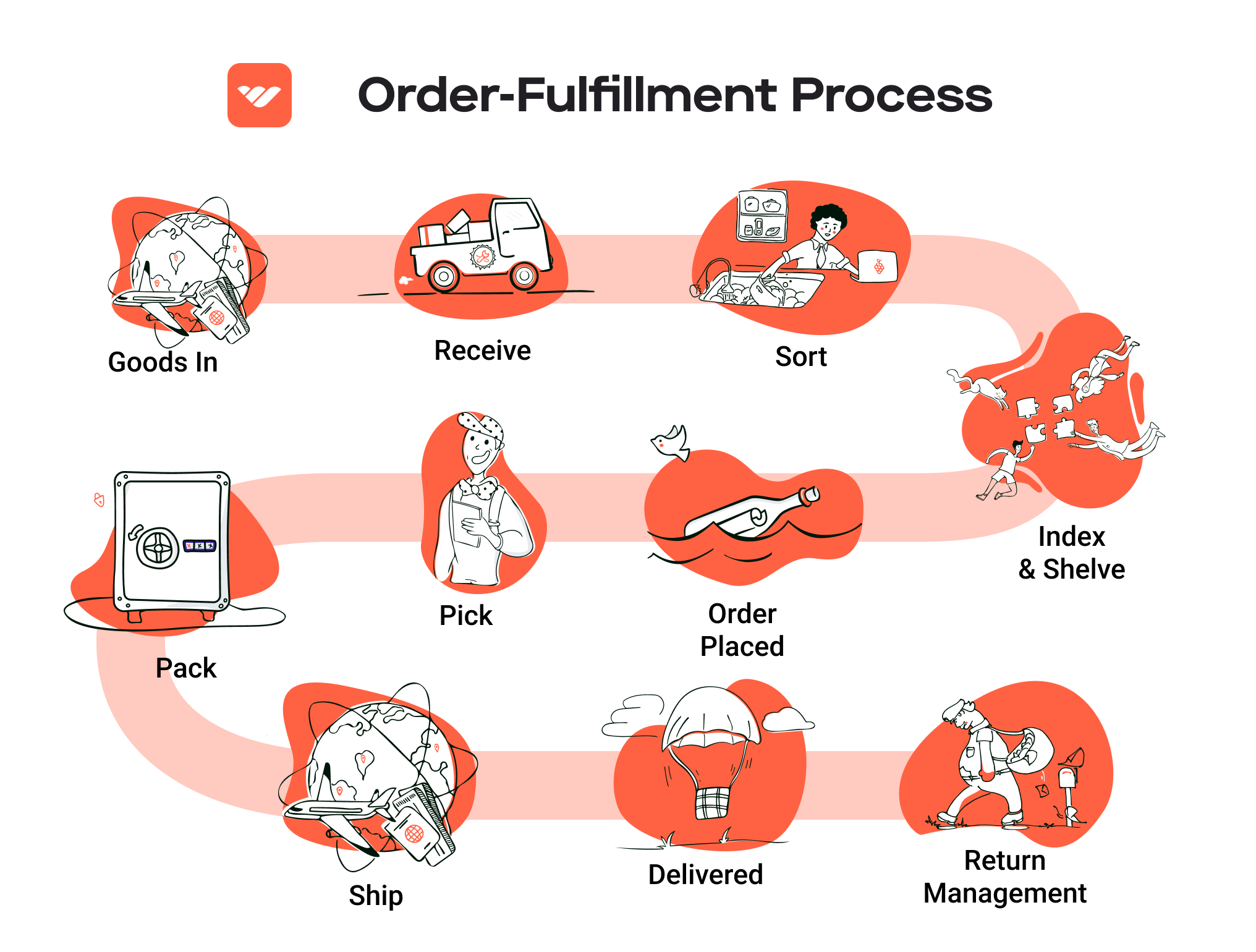
Comparing Fulfillment Models: In-House vs. 3PL vs. Dropshipping
Fulfillment Model Comparison
| Model | Who Handles Inventory | Best For (Business Stage) | Key Advantage | Key Disadvantage |
|---|---|---|---|---|
| In-House Fulfillment | The business itself | Established businesses | Full control over operations and branding | High overhead costs and resource-intensive |
| Third-Party Logistics (3PL) | A third-party provider | Growing to mid-sized businesses | Scalability and expertise in logistics | Less control over the fulfillment process |
| Dropshipping | Suppliers or manufacturers | Startups and small businesses | Low upfront investment and inventory risk | Lower profit margins and dependency on suppliers |
In-House Fulfillment
In-house fulfillment refers to the process where a business manages its own inventory and order fulfillment operations. This model is most suitable for established businesses that have the resources to handle logistics internally. Companies that choose this approach benefit from having complete control over their fulfillment processes, which allows for tailored branding and customer service experiences. They can implement specific packaging, shipping methods, and return policies that align with their brand values. Moreover, in-house fulfillment can lead to quicker response times and greater flexibility in operations, as businesses can easily adjust their processes without needing to coordinate with external partners.
However, the in-house model comes with significant drawbacks. The overhead costs are often high due to the need for warehousing space, staffing, and technology investments. Moreover, managing logistics can be resource-intensive, diverting attention from core business activities such as marketing and product development. This can be particularly challenging during peak seasons when order volumes surge, requiring additional labor and infrastructure that may not be sustainable long-term.
Third-Party Logistics (3PL)
Third-party logistics (3PL) providers are specialized companies that handle inventory and order fulfillment for businesses. This model is ideal for growing to mid-sized businesses that require scalability without the burden of managing logistics themselves. By partnering with a 3PL, companies can leverage the provider’s expertise in logistics, which often includes advanced technology, efficient warehousing, and established shipping relationships. This can result in faster shipping times, improved order accuracy, and cost savings through bulk shipping rates.
The primary disadvantage of using a 3PL is the reduction in control over the fulfillment process. Companies must rely on their 3PL partner to adhere to service level agreements and maintain the quality of service that reflects their brand. Miscommunication or mistakes in fulfillment can lead to customer dissatisfaction, which can be detrimental to a brand’s reputation. Additionally, integrating technology systems between the business and the 3PL can sometimes present challenges, especially if the systems are not compatible.
Dropshipping
Dropshipping is a fulfillment model where businesses sell products without holding any inventory. Instead, when a customer places an order, the retailer purchases the item from a third-party supplier who ships it directly to the customer. This model is particularly beneficial for startups and small businesses that have limited capital and want to minimize financial risks associated with inventory. Since there is no need to invest in inventory upfront, businesses can test different products without significant financial commitment. This flexibility allows for quick adjustments to product offerings based on market demand.
Despite its advantages, dropshipping has notable drawbacks. The profit margins tend to be lower since retailers often pay a premium for the convenience of not holding inventory. Additionally, businesses that rely on dropshipping are highly dependent on their suppliers for inventory availability, quality control, and shipping reliability. Any delays or errors on the supplier’s end can directly impact customer satisfaction and lead to lost sales. Furthermore, with the rise in popularity of dropshipping, competition has intensified, making it essential for businesses to differentiate themselves through marketing and customer service to succeed.
Conclusion
Choosing the right fulfillment model is a crucial decision that can significantly impact your e-commerce business’s growth and sustainability. In-house fulfillment offers control but at a high cost, while 3PL provides scalability and expertise, albeit with some loss of control. Dropshipping presents an accessible entry point for new businesses but comes with challenges in profit margins and supplier dependencies. Assessing your business’s current stage, resources, and long-term goals will help you determine the most suitable fulfillment model to support your operations.
A Deep Dive into Amazon FBA: Pros, Cons, and Who It’s For
Understanding Fulfillment by Amazon (FBA)
Fulfillment by Amazon (FBA) is a service that allows e-commerce businesses to store their products in Amazon’s fulfillment centers. Amazon takes care of storage, packaging, shipping, and customer service, allowing sellers to focus on growing their business. When a customer orders a product, Amazon handles the entire fulfillment process, from picking the item off the shelf to shipping it directly to the customer. This service is particularly beneficial for businesses looking to scale, as it leverages Amazon’s extensive logistics network and customer trust.
How FBA Works
-
Setup: Businesses start by creating an Amazon seller account and enrolling in the FBA program. They list their products on Amazon and prepare them for shipment to one of Amazon’s fulfillment centers.
-
Shipping to Amazon: Sellers send their inventory to Amazon, where it is stored in their warehouses. Amazon provides guidance on how to package and label items to ensure they meet their requirements.
-
Storage and Inventory Management: Once received, products are stored in Amazon’s warehouses. Sellers can monitor their inventory levels through the Amazon Seller Central dashboard.
-
Order Fulfillment: When a customer places an order, Amazon picks, packs, and ships the product. They also handle customer service inquiries and returns.
-
Payment: After the sale, Amazon disburses payment to the seller, minus applicable fees.
Pros of Using FBA
Prime Eligibility
One of the most significant advantages of FBA is that products become eligible for Amazon Prime. This means that Prime members can enjoy free two-day shipping, which can significantly increase visibility and sales, as many consumers prefer Prime-eligible products.
Customer Trust
Amazon has built a reputation for reliability and customer service. By using FBA, sellers can leverage this trust, as customers are more likely to purchase items fulfilled by Amazon due to their assurance of fast shipping and hassle-free returns.
Multi-Channel Fulfillment
FBA allows sellers to fulfill orders not only from Amazon but also from other sales channels, such as their own e-commerce websites. This versatility enables businesses to centralize their fulfillment operations, simplifying logistics and inventory management.
Scalability
FBA is designed for scalability. As sales increase, sellers can rely on Amazon’s robust infrastructure to handle order volume without needing to invest in additional warehousing or logistics resources.
Reduced Operational Burden
By outsourcing fulfillment to Amazon, sellers can focus on marketing, product development, and customer engagement rather than the complexities of logistics and warehousing.
Cons of Using FBA
High Fees
While FBA offers numerous benefits, it comes with associated costs. Sellers incur storage fees for holding inventory in Amazon’s warehouses, as well as fulfillment fees based on the size and weight of products. These fees can add up, especially for lower-margin items.
Strict Inventory Rules
Amazon has strict guidelines regarding inventory management, including limits on the amount of inventory that can be stored and how it must be labeled. Sellers need to ensure compliance to avoid penalties or removal of their products.
Commingling Risks
FBA operates on a commingling model, meaning that products from different sellers can be stored together. This can lead to issues if a seller’s products are damaged or if customers receive items from other sellers. While Amazon provides protections, the risk remains a concern for some businesses.
Loss of Control
By utilizing FBA, sellers relinquish some control over the fulfillment process. This can be problematic if there are specific branding or packaging requirements that Amazon cannot accommodate.
Complexity of Returns
While Amazon handles returns, this can lead to complications for sellers. Returned items may not always be in sellable condition, and tracking these returns can become complex, particularly for businesses with higher return rates.
Who is FBA Best For?
FBA is particularly well-suited for certain types of businesses:
-
Small to Medium-Sized Businesses: Companies that may not have the resources to manage their own logistics can benefit from FBA’s comprehensive services.
-
E-commerce Startups: Startups looking to rapidly scale and tap into Amazon’s massive customer base can leverage FBA to gain traction without significant upfront investment in logistics.
-
Brands with High Sales Volume: Businesses that sell a high volume of products can take advantage of the efficiency of Amazon’s fulfillment centers, reducing operational burdens and enhancing customer satisfaction.
-
Sellers of Fast-Moving Consumer Goods: Products that have a quick turnover rate and are eligible for Prime will likely see improved sales when fulfilled by Amazon.
-
Multi-Channel Sellers: Businesses that sell across various platforms can streamline their operations by using FBA for all fulfillment, maintaining consistency in shipping and customer service.
In conclusion, Fulfillment by Amazon offers a robust solution for e-commerce businesses looking to scale and reach a wider audience. By carefully weighing the pros and cons, and considering specific business needs, sellers can determine if FBA is the right fit for their operations.
Core Services Offered by Fulfillment Centers
Inventory Management & Warehousing
Effective inventory management and warehousing are foundational services provided by fulfillment centers. This involves the systematic control of stock levels, ensuring that products are stored efficiently and accurately. Fulfillment centers utilize advanced Warehouse Management Systems (WMS) that provide complete visibility across various sales channels, allowing e-commerce businesses to track inventory in real time, monitor orders, and maintain accurate stock levels.
Benefits:
1. Optimized Stock Levels: By leveraging data-driven insights, fulfillment centers help businesses maintain optimal inventory levels, reducing the risk of stockouts or overstock situations. This is crucial for e-commerce businesses that operate on just-in-time inventory models.
-
Reduced Operational Overhead: Advanced inventory management reduces the need for extensive in-house storage and staffing. This enables businesses to focus on core activities such as marketing and customer engagement, rather than logistics.
-
Scalability: As your business grows, fulfillment centers can easily scale operations to meet increasing demand, ensuring that you can handle peak seasons without compromising service quality.
-
Enhanced Accuracy: Fulfillment centers employ stringent quality control measures to minimize errors, ensuring that products are accurately accounted for, which is vital for maintaining customer trust.
Pick and Pack Services
Pick and pack services are essential for e-commerce businesses looking to streamline order fulfillment. This process involves selecting items from inventory (picking) and packaging them for shipment (packing). Fulfillment centers use sophisticated systems to ensure that the right products are picked accurately and efficiently, often utilizing barcodes and automated picking technologies.
Benefits:
1. Speed and Efficiency: Fulfillment centers are designed to process orders rapidly. With well-trained staff and optimized workflows, businesses can benefit from faster order turnaround times, which is critical for customer satisfaction.
-
Accuracy in Order Fulfillment: High pick and pack accuracy reduces the likelihood of returns and customer dissatisfaction. Many fulfillment centers guarantee a certain level of accuracy, ensuring that the right products reach the right customers.
-
Cost-Effective Operations: By outsourcing pick and pack services, e-commerce businesses can reduce labor costs and avoid the expenses associated with maintaining in-house fulfillment operations.
-
Customization Options: Many fulfillment centers offer customizable packing solutions, including branded packaging and gift options, which can enhance the customer experience and reinforce brand identity.
Kitting and Assembly
Kitting and assembly services involve the grouping of individual items into a single package or kit, which can be particularly beneficial for e-commerce businesses that sell products as sets or bundles. This service can also include the assembly of multi-component products that require pre-assembly before shipping.
Benefits:
1. Streamlined Order Processing: By pre-assembling kits, fulfillment centers can significantly reduce the time required to process individual orders. This is particularly advantageous during peak sales periods.
-
Increased Average Order Value: Kitting allows businesses to offer bundled products at a discounted rate, encouraging customers to purchase more items in a single transaction. This strategy can enhance overall sales revenue.
-
Improved Customer Satisfaction: Providing well-assembled kits ensures that customers receive complete products without the hassle of assembly, leading to a better overall shopping experience.
-
Inventory Management Efficiency: Kitting can simplify inventory management by consolidating multiple items into a single SKU, making it easier to track stock levels and forecast demand.
Returns Management (Reverse Logistics)
Returns management, or reverse logistics, is a critical service provided by fulfillment centers that focuses on handling product returns efficiently. This includes processing returns, inspecting returned items, restocking them, and managing the inventory accordingly.
Benefits:
1. Enhanced Customer Experience: A streamlined returns process can significantly improve customer satisfaction. Quick and hassle-free returns encourage customers to shop more frequently, knowing that they can easily return products if necessary.
-
Cost Reduction: Efficient returns management helps minimize losses associated with returned products. Fulfillment centers can quickly assess returned items and determine whether they can be restocked or need to be discounted, thus maximizing recovery.
-
Data Insights: Analyzing return data can provide valuable insights into customer preferences and product issues. This information can inform future product development and marketing strategies.
-
Brand Loyalty: A positive returns experience can foster customer loyalty. By providing excellent service in managing returns, businesses can differentiate themselves in a competitive market, encouraging repeat purchases.
By leveraging these core services offered by fulfillment centers, e-commerce businesses can not only improve operational efficiency but also enhance customer satisfaction and loyalty, ultimately driving growth and profitability.
How to Choose a Fulfillment Partner: A 6-Point Checklist
Location & Warehouse Network
Importance: The geographical location of your fulfillment partner is critical for optimizing shipping times and costs. A partner with strategically located warehouses can facilitate quicker deliveries to your customers, particularly in regions where you have a high volume of sales.
Questions to Ask:
– What are the locations of your fulfillment centers, and how do they align with my customer base?
– How do you handle shipping logistics in various regions?
– Can you provide details on your average shipping times and costs for different areas?
Technology & Integrations
Importance: In today’s e-commerce landscape, technology plays a pivotal role in streamlining operations. A fulfillment partner with robust technology can provide real-time inventory tracking, automated order processing, and seamless integrations with your e-commerce platform.
Questions to Ask:
– What warehouse management system (WMS) do you use, and how does it enhance order fulfillment?
– Can your system integrate with my current e-commerce platform (e.g., Shopify, WooCommerce)?
– Do you offer EDI capabilities for efficient data exchange?
– How do you ensure data security and compliance?
Specializations (e.g., Cold Storage, Oversized Items)
Importance: Depending on your product range, you may require specialized services. If you sell perishable goods, fragile items, or oversized products, ensuring that your fulfillment partner has the appropriate facilities and expertise is essential.
Questions to Ask:
– Do you have specialized storage solutions, such as cold storage or facilities for oversized items?
– What are your capabilities for handling fragile or high-value products?
– How do you ensure the quality and safety of specialized items during storage and shipping?
Scalability & Capacity
Importance: As your business grows, your fulfillment needs will evolve. A fulfillment partner should be able to scale alongside your business, accommodating increased order volumes and expanding product lines without compromising service quality.
Questions to Ask:
– How do you handle peak seasons or sudden spikes in order volume?
– What is your capacity for storing additional inventory as my business scales?
– Can you provide examples of how you have supported other clients during periods of growth?
Pricing and Contracts
Importance: Understanding the pricing structure and contract terms is vital for budgeting and financial planning. Transparent pricing with no hidden fees helps avoid unexpected costs that can impact your profitability.
Questions to Ask:
– What is your pricing model (e.g., per order, per item, monthly fees)?
– Are there any additional costs for services such as returns processing or special handling?
– Can you provide a sample contract for review?
– What is your policy for contract termination or changes in service requirements?
Customer Support & Reviews
Importance: Exceptional customer support can make a significant difference in your fulfillment experience. A responsive partner can quickly address issues and ensure smooth operations, enhancing overall customer satisfaction.
Questions to Ask:
– What support channels do you offer (e.g., phone, email, chat), and what are your response times?
– Can you provide references or case studies from existing clients?
– How do you handle fulfillment errors or issues that arise?
– What feedback mechanisms are in place to improve service quality?
Conclusion
Choosing the right fulfillment partner is a crucial step in scaling your e-commerce business. By carefully evaluating potential partners against this checklist, you can ensure that you select a 3PL provider that aligns with your operational needs and growth objectives. Take the time to ask detailed questions and seek clarity on any areas of concern, as this partnership will significantly impact your logistics efficiency and customer satisfaction.
Understanding Fulfillment Pricing: A Breakdown of Common Fees
Initial Setup Fees
Initial setup fees are typically incurred when you first engage with a fulfillment center. These fees cover the costs associated with onboarding your business, including integrating your existing systems with the fulfillment provider’s platform. The fee may vary based on the complexity of the integration, the volume of products, and the specific requirements of your business.
For instance, if you’re utilizing a sophisticated inventory management system, expect higher setup fees due to the additional technical work required. Conversely, businesses with straightforward needs may incur lower fees. It’s essential to ask potential partners about their setup process and any associated costs to avoid surprises.
Receiving Fees
Receiving fees are charged when inventory is delivered to the fulfillment center. This fee compensates the facility for the labor involved in unloading, inspecting, and shelving your products. Typically calculated per pallet or per hour of labor, these fees can fluctuate based on the volume and complexity of the shipment.
For example, if you send a large shipment of varied products that requires extensive sorting, the receiving fees could be higher. It’s advisable to negotiate these fees based on your expected shipment frequency and size, as some fulfillment centers may offer discounts for regular or bulk deliveries.
Storage Fees (per pallet/bin)
Storage fees are assessed for the space your inventory occupies within the fulfillment center. These fees can be charged on a per-pallet or per-bin basis, depending on how your products are stored. The cost usually varies by location and is influenced by factors such as the facility’s operational costs and the demand for storage space.
For example, if your products are large and take up more space, you will pay more in storage fees. Conversely, smaller items may incur lower fees. It’s crucial to analyze your inventory turnover rate; items that move quickly may justify higher storage costs, while slow-moving inventory could lead to unnecessary expenses. Regularly reviewing your inventory strategy can help you minimize these fees.
Pick & Pack Fees (per item/order)
Pick and pack fees are charged for the process of selecting items from inventory and preparing them for shipment. These fees can be calculated per item or per order, depending on the fulfillment center’s pricing model. The complexity of the order often influences these costs; for instance, an order that includes multiple items may incur higher fees compared to a single-item order.
When evaluating fulfillment partners, consider how they define “pick” and “pack” actions. Some may charge separately for each, while others may bundle them into a single fee. Understanding these nuances is key to accurately forecasting fulfillment costs.
Shipping Fees
Shipping fees encompass the costs related to delivering orders to customers. These fees are influenced by several factors, including the shipping method, destination, package dimensions, and weight. Fulfillment centers often have established relationships with carriers, allowing them to offer competitive shipping rates.
It’s essential to clarify whether shipping fees are passed directly to your business or if they are included in the overall fulfillment pricing. Additionally, consider the fulfillment center’s ability to offer various shipping options, such as expedited or standard shipping, as this flexibility can enhance customer satisfaction and potentially reduce costs.
Tips for Getting an Accurate Quote
-
Be Transparent About Your Needs: Clearly outline your business model, order volume, and any unique requirements to get the most accurate quote. This includes detailing your inventory size, product types, and expected seasonal fluctuations.
-
Request Itemized Pricing: An itemized quote helps you understand each component of the pricing model. It also allows for easier comparison between different fulfillment providers.
-
Consider Future Growth: Discuss your growth projections with potential partners. Some fulfillment centers may offer scalable solutions that can adapt to your evolving business needs.
-
Ask About Additional Fees: Inquire about any potential hidden costs, such as fees for returns, special packaging, or additional handling. Understanding these fees upfront can prevent budget overruns.
-
Evaluate Service Levels: Different fulfillment centers may offer varying service levels. Determine if the pricing reflects the quality of service you require, especially if you have strict deadlines or high customer expectations.
By understanding these common fulfillment pricing models and following these tips, you can make informed decisions that align with your e-commerce goals, ultimately leading to a more efficient and cost-effective fulfillment strategy.
Frequently Asked Questions (FAQs) about Fulfillment
1. What is the Nordstrom Fulfillment Center?
The Nordstrom Fulfillment Center is a specialized facility designed to handle order processing for both Nordstrom retail stores and direct-to-consumer (D2C) sales. It utilizes advanced technology and automation to ensure efficient inventory management and order fulfillment, allowing for rapid delivery to customers and retail locations.
2. How does Nordstrom’s fulfillment process work?
Nordstrom’s fulfillment process involves receiving inventory, storing it in a systematic manner, and picking and packing items for shipment. Orders are processed through an automated system that optimizes the routing and prioritization based on various factors like processing time and customer location, ensuring timely delivery.
3. What are the benefits of using a fulfillment center like Nordstrom’s?
Using a fulfillment center like Nordstrom’s allows businesses to streamline their logistics operations. Benefits include faster order processing, improved inventory management, reduced shipping costs, and access to advanced technology and infrastructure that enhance overall efficiency and customer satisfaction.
4. What’s the difference between a warehouse and a fulfillment center?
A warehouse primarily focuses on storing goods, while a fulfillment center is designed to process orders and ship products directly to customers. Fulfillment centers are equipped with technology for inventory management, order picking, packing, and shipping, making them essential for e-commerce businesses looking to optimize their logistics.
5. What is a 3PL (Third-Party Logistics)?
A 3PL is a service provider that manages logistics and supply chain operations for businesses, including warehousing, inventory management, and order fulfillment. By outsourcing these functions to a 3PL, companies can focus on their core business activities while benefiting from the expertise and resources of logistics specialists.
6. How much do fulfillment services cost?
Fulfillment service costs can vary widely based on factors such as order volume, storage space requirements, and specific services provided (e.g., kitting, returns management). Generally, costs may include receiving fees, storage fees, pick-and-pack fees, and shipping fees. It’s advisable to request quotes from multiple providers to compare pricing structures.
7. How does Nordstrom ensure compliance with fulfillment standards?
Nordstrom maintains strict compliance with fulfillment standards through detailed routing guides and operational protocols. This includes precise labeling, packaging requirements, and adherence to shipping timelines. They also leverage technology to monitor compliance and streamline operations, reducing the risk of errors.
8. Can I integrate my existing e-commerce platform with Nordstrom’s fulfillment services?
Yes, Nordstrom’s fulfillment services are designed to integrate with various e-commerce platforms. This allows businesses to manage their online orders seamlessly while utilizing Nordstrom’s advanced logistics capabilities. Integration can enhance inventory visibility and order tracking for a better customer experience.
9. What technologies are used in Nordstrom’s fulfillment center?
Nordstrom’s fulfillment center employs cutting-edge technologies, including automated storage and retrieval systems, dynamic routing algorithms, and real-time inventory management software. These innovations help to maximize space, improve order accuracy, and enhance overall operational efficiency.
10. How does Nordstrom handle returns and exchanges?
Nordstrom has established processes for managing returns and exchanges efficiently. Customers can initiate returns online or in-store, and the fulfillment center is equipped to process returned items quickly, ensuring that inventory levels are updated and that customers receive prompt service for exchanges or refunds.
Conclusion: Is Outsourcing Fulfillment the Right Move for Your Business?
Key Benefits of Outsourcing Fulfillment
Outsourcing fulfillment services can be a game-changer for e-commerce businesses looking to scale efficiently. One of the most significant advantages is the time savings it offers. By delegating logistics tasks to a specialized partner, you free up valuable resources that can be redirected towards core business functions such as product development, marketing, and customer service. This allows you to focus on strategic growth rather than getting bogged down in day-to-day operations.
Scalability is another critical benefit. As your business grows, so do your fulfillment needs. A reliable fulfillment partner can adapt to fluctuations in order volume, seasonal spikes, and expanding product lines without the need for substantial investments in infrastructure or staffing. This flexibility can be particularly advantageous during peak shopping seasons when demand can surge unexpectedly.
Moreover, partnering with an experienced fulfillment service grants you access to industry expertise and advanced technology. Many fulfillment centers, like those catering to Nordstrom’s standards, utilize state-of-the-art systems for inventory management and order processing, ensuring accuracy and efficiency. This not only enhances customer satisfaction through timely deliveries but also helps maintain compliance with retail requirements.
Choosing the Right Partner for Growth
While the benefits of outsourcing fulfillment are clear, the importance of selecting the right partner cannot be overstated. Your fulfillment provider should align with your business goals, understand your unique needs, and be equipped to handle the complexities of your logistics requirements. A thorough vetting process, including a review of their capabilities, technology, and customer service, is essential for ensuring a successful partnership.
Take Action
If you’re considering outsourcing your fulfillment, now is the time to audit your current shipping processes. Assess your operational challenges, inventory management, and shipping costs to determine if a fulfillment partner could be the strategic next step in your growth journey. By making informed decisions, you can position your business for long-term success in the competitive e-commerce landscape.
Important Disclaimer
⚠️ Important Disclaimer
The information in this guide is for educational purposes. Fulfillment services, pricing, and platform features change frequently. Always conduct your own due diligence and consult with providers directly before making business decisions.
